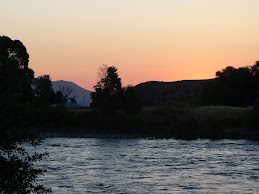
Chorro had to wait in the car, but there were three small dogs outside that reminded him of his cousins back in Wyoming, so he was content to sit there and talk with them a bit while I toured the museum and site.
The tribe who inhabited this village was stable with an agricultural society. They lived in huts and grew corn, beans and pumpkins, similarly to the Anasazi who lived to the west about the same time. The Caddo Indians here also hunted buffalo, a fact determined from excavating the village. The diorama below is dark and a little out-of-focus, but it shows how the village might have looked, based on what remains. There is a round hut in the foreground and the mounds at the center, back, towards the left. The funny little white things in the upper half of the picture are clouds. Aren't they cute? The indistinct stuff on each side is a reflection on the glass in front of the diorama.
 Many beautiful artifacts were unearthed in ecavating these mounds. These are excellently made points.
Many beautiful artifacts were unearthed in ecavating these mounds. These are excellently made points. And the pottery is beautiful.
And the pottery is beautiful.

This pictures shows actual mounds. To the right, the mound i(with the shelter on it) is a burial site for chiefs or important persons in the village. To the left, the mound is a ceremonial site.

Under the shelter is this excavation of the site. The bones and artifacts are replicas, not the real thing. Their placement represents where the actual items were found. An interesting note was that this male, about 50, had arthritis, as can be determined from the size of his knees. There were two burial excavations at this mound.

This mound is a ceremonial site. It held a structure that represented, perhaps, a temple, in which there was a continuously burning fire. When the current chief of the village died, the temple was burned and a new one contstructed on top of it. Thus the mound. The burial mound was different in that it held only two separate graves and they were not on top of each other. Other unexcavated mounds in the area were presumably also burial sites.

I think it is fascinating to find these advanced civilizations of "savages" in the history of this land. I'm still puzzling about the Northern Europeans who slaughtered ruthlessly to "own" the land, which is a strange concept in itself.
Back at the car, Chorro sat uncomfortably while a little shaggy blonde dog who could have passed for Chorro's little brother was barking loudly at him on the outside. I don't know what kind of claims Chorro made on the little guy's territory, but he chased us barking waaaaayy down the lane.
So ended another good day.



















































 But there were unmistakable signs of winter approaching in the park.
But there were unmistakable signs of winter approaching in the park.
 dinosaurs?
dinosaurs? and more, still to be untangled.
and more, still to be untangled.


 Today was a good day.
Today was a good day.